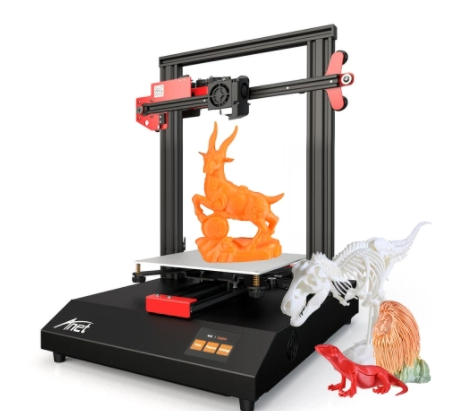FDM is the abbreviation of Fused Deposition Modeling, which means fused deposition molding, it builds a three-dimensional model by stacking thermoplastics layer by layer. FDM technology is the most widely used in desktop models because of its simple manufacturing, easy design, relatively low manufacturing, and maintenance costs. The principle is to melt the filamentous hot-melt material at a high temperature and then extrude it through a fine nozzle to form very fine filaments stacked layer by layer. Repeat this process to form a complete product. This process is just like making a cake. Put the ingredients in a cone-shaped plastic film container, squeeze the cream out layer by layer, and finally form the cream cake we want.
The price of entry-level FDM 3D printers is currently as low as $200, such as Anet ET4 3D Printer, the price is $156 in Germany Warehouse and it is currently using mature 3D printing technology. The price of consumables is relatively cheap, which makes FDM 3D printers suitable for enterprises and individual users.
What are the advantages of FDM technology?
The advantage of FDM technology is that it is not limited by the size of printed items and can print very large items. For example, the 3D printed houses that we often see on the news use FDM molding technology. Compared with SLA technology, the accuracy of the items printed by FDM is slightly inferior. If you want to print precision parts or smooth ceramic products, it may not be the best choice.
What are the materials used in FDM technology?
FDM materials include all thermoplastic materials. As long as they have the characteristic of “melting when heated and solidifying after cooling”, this technology can basically be used for 3D printing. The very popular 3D printed pancakes, cakes, and other foods also use FDM technology. But our commonly used material is PLA, which is an environmentally friendly material extracted from corn, non-toxic, and environmentally friendly.
What is SLA technology?
SLA technology mainly uses photosensitive resin as the raw material and scans the surface of the photosensitive resin point by point through a computer-controlled ultraviolet laser. The thin layer of resin in the scanned area is cured by photopolymerization to form a thin layer of the part. After the curing of one layer is completed, the workbench moves down a distance of the thickness of the layer and solidifies layer by layer, and finally, a complete article is obtained. SLA molding technology 3D printers are mostly industrial grade.

What are the advantages of SLA technology?
SLA is suitable for printing objects that require high accuracies, such as orthodontic models, or high-precision small parts, such as some beautifully made rings, and also suitable for printing objects with relatively smooth surfaces, such as ceramics. The beauty of the light-curing molding method is that it cannot print larger-sized objects, which is limited by its technical principles.
What are the materials used in SLA technology?
The material used in SLA technology is mainly photosensitive resin, which has certain toxicity. Certain protective measures need to be taken during the printing process.






